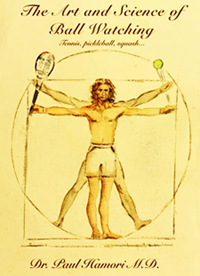Ball Watching
Part 2
Paul Hamori, MD

There many great ball watching in tennis beside Roger Federer. There are also some fantastic players who have really poor ball watching.
Theoretically you can play great tennis without great ball watching. But I believe Federer's ball watching is foundational to his beautiful game and the tennis magic we see when he takes the court.
We are all familiar with his prolonged sideways head position. But what my research found was something additional that I don't believe has ever been studied.
This is a pronounced narrowing of his eyes around contact. Furthermore, on a significant percentage of his shots, he goes on to actually close his eyes after contact.
That's right. Narrowed and/or closed eyes. Surprised? Read on.
The Data
As I said in Part 1 of this series (Click Here) I have watched Federer play live over 40 times. But to get to the root of his ball watching technique I needed evidence.
I developed this by photographing him in practice. I watched him practice 2 hours a day for 2 consecutive days taking non-stop photos with the burst feature on a DSLR camera.
Then I analyzed the data. It came out to 300 separate shot sequences with a total of 1500 still photos. The results were unexpected—shocking even.

Surprise of the Eyes
When I began analyzing my photographs, I expected to find Federer's eyes wide open and on the ball. However, quite surprisingly the pictures I took showed that Federer actually narrows his eyes as he approaches contact the vast majority of the time.
Even more surprising sometimes he actually closes his eyes after contact. So I broke down what happened with his eyes stroke by stroke based on over 125 example sequences.

Forehand
|

Backhand
|
|
|
|
Groundstrokes

On his groundstrokes Federer's eyes did remained wide open 17% of the time. But on 82% of all groundstrokes he distinctly narrowed his eyes.
And on a significant percentage of groundstrokes he went on to close his eyes after contact. 16% of the time on his forehand and 13% of the time on his backhand.
Volleys
There was a similar phenomenon when it came to his volleys, although I found a significant difference between his forehand and backhand volleys.
Obviously volleys differ from groundstrokes in several ways. First, the hitting cycle is more like 1 second than 2 seconds.
The reduced backswing means slower racket head speeds. Also the entire shot happens in front of the player.

I think these factors probably make it easier for the player to track the ball racket and see contact.But there were significant technical differences between the two sides.
The backhand volley is similar to a shortened version of the slice backhand. On the backhand volley, Federer narrowed his eyes 66% of the time. 41% of the time he went on the close them after contact.
The forehand volley has less similarity to a forehand groundstroke—even a sliced forehand. I think this makes it a more difficult and less reliable shot.
But whatever the reasons, my data showed the eye results are quite different on the forehand volley. Federer narrowed his eyes only 9% of the time and I didn't record one example of them going on to close. 91% of the time they were wide open.
One possible mitigating factor was the small number of forehand volleys I recorded compared to the other shots. But it's unlikely that even with more examples the results on the forehand volley would approach the backhand volley or the groundstrokes.

Backhand Volley
|

Forehand Volley
|
|
|
|
One commonality between the volleys and the groundstrokes however was that, regardless of the eyes, Federer turned his head sideways and kept it there until after contact, not turning to immediately follow the ball.
So what does all this mean? We've seen the limitations in human vision in Part 1. Click Here. Now we know that Federer's use of his eyes has the completely unexpected qualities of narrowing and even closing.
How can we craft this information into a step by step technique to develop Federer style ball watching? Stay tuned.





